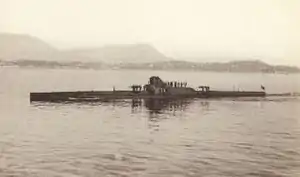 Joessel, 1913 | |
| Class overview | |
|---|---|
| Name | Joessel class |
| Operators | |
| Preceded by | Armide class |
| Succeeded by | Lagrange class |
| Built | 1913 – 1920 |
| Planned | 8 |
| Completed | 2 |
| Cancelled | 6 |
| Retired | 2 |
| General characteristics | |
| Type | Submarine |
| Displacement | |
| Length | 74 m (242 ft 9 in) |
| Beam | 6.4 m (21 ft 0 in) |
| Draught | 3.62 m (11 ft 11 in) |
| Propulsion |
|
| Speed |
|
| Range |
|
| Complement | 47 |
| Armament |
|
The Joessel-class submarines were a class of two diesel-electric submarines built for the French Navy laid down before the start of World War I and completed after. They were built in the Arsenal de Cherbourg from 1913 to 1920, before entering the French Marine Nationale in 1920 and serving until 1936.
Design
The Joessel class was ordered as part of the French fleet's 1914 program. The ships were designed by Jean Simonot, as a modification of his previous project, Gustave Zédé, using two Parsons steam turbines with a power of 2,000 hp (1,491 kW). During construction, though, the idea was abandoned and the ships were instead equipped with diesel engines.[1][2][3]
The submarines had a surfaced displacement of 870 long tons (884 t) and a submerged displacement of 1,247 long tons (1,267 tonnes). The dimensions were 74 metres (242 feet 9 inches) long, with a beam of 6.4 m (21 ft 0 in) and a draught of 3.62 m (11 ft 11 in). They had two shafts powered by two diesel engines built by Schneider-Carels for surface running with a combined total of 2,700 hp (2,013 kW) and two electric motors which together produced 1,640 horsepower (1,220 kilowatts) for submerged propulsion. Their maximum speed was 16.5 knots (30.6 kilometres per hour; 19.0 miles per hour) on the surface and 11 knots (20 km/h; 13 mph) while submerged with a surfaced range of 4,300 nautical miles (8,000 kilometres; 4,900 miles) at 10 knots (19 km/h) and a submerged range of 125 nautical miles (232 km) at 5 knots (9.3 km/h). Her complement was 47 men.[1][Note 1][2][3]
The ships were armed with eight 450 mm torpedo tubes (four in the bow, two stern and two external trainable mounts), with a total of 10 torpedoes and two 75 mm (3.0 in) guns.[1][2][3]
Ships
Two Joessel-class submarines were built in the Arsenal de Cherbourg, France. The ships were laid down in November 1913,[1] launched between 1917 and 1919, and completed in 1920. Joessel received the pennant number Q 109, and Fulton, Q 110. It was planned to build six additional ships of this type, numbered Q 115 to Q 120, but the order was canceled in the course of World War I.[1][2][3]
| Joessel-class submarines | ||||
| Name | Laid down | Launched | Completed | Fate |
|---|---|---|---|---|
| Joessel | November 1913 | 21 July 1917 | February 1920 | Stricken in May 1936.[3] |
| Fulton | November 1913 | 1 April 1919 | July 1920 | Stricken in May 1936.[3] |
Service

After completion, the ships were refitted: they received a new higher cylindrical conning tower, bridge and two periscopes of 7.5 m (at the conning tower) and 9.5 m (in the central operations room).[1][2]
The ships served in the Atlantic until the early 1930s and were transferred to Indochina. They were stricken in May 1936.[3]
Notes
- ↑ Couhat gives 2 x 450 BHP diesels and 2 x 850 SHP electric motors
Citations
References
- Couhat, Jean Labayle (1974). French Warships of World War I. London: Ian Allan. ISBN 0-7110-0445-5.
- Gardiner, Robert; Gray, Randal (1985). Conway's All the World's Fighting Ships 1906–1921. London: Conway Maritime Press. ISBN 978-0-85177-245-5.
- Fontenoy, Paul E. (2007). Submarines: An Illustrated History of Their Impact. ABC-CLIO Publishing. ISBN 978-1-85109-563-6.